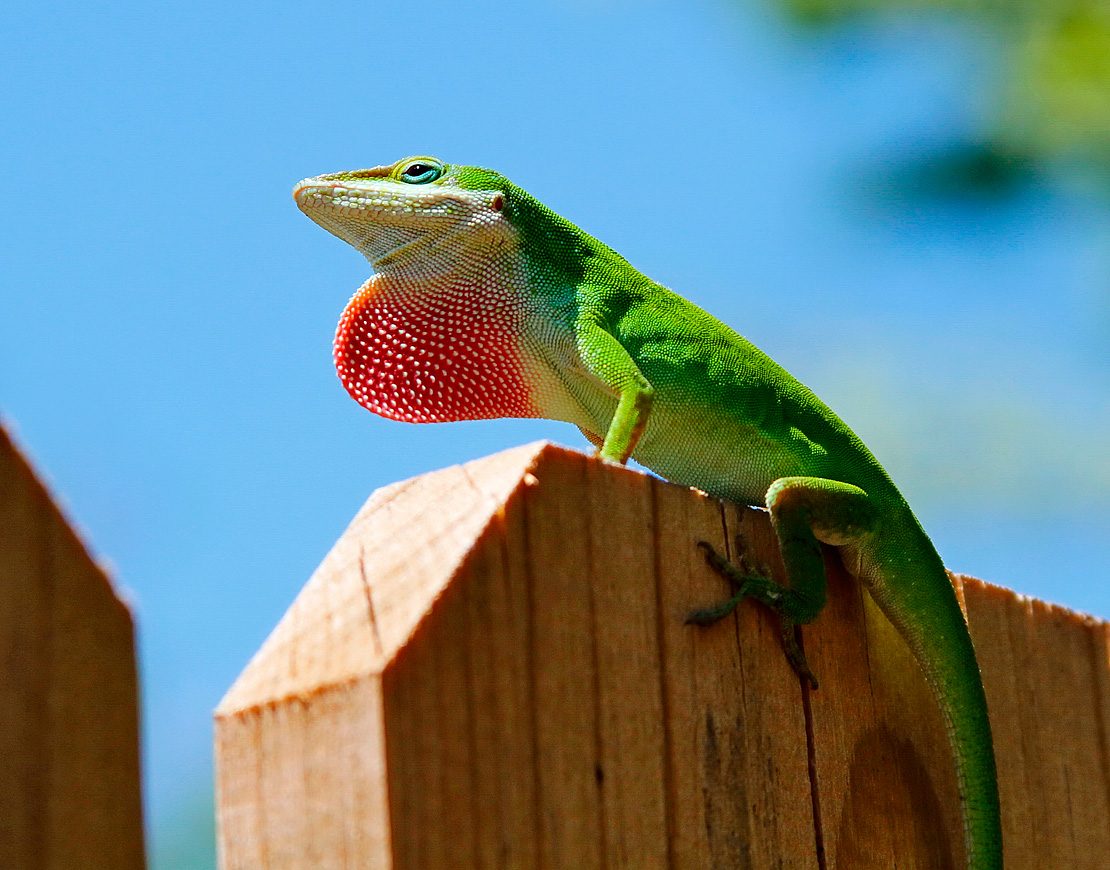Anole (Carolina)
The Carolina anole (Anolis carolinensis) is an arboreal lizard found primarily in the southeastern United States and some Caribbean islands. Other common names include the green anole, American anole and red-throated anole. It is also sometimes referred to as the American chameleon due to its ability to change color from several brown hues to bright green. While many kinds of lizards are capable of changing color, anoles are closely related to iguanas and are not true chameleons. The Carolina is a small lizard; male adults are usually 15 cm (5.9 in) long, about half of which is its tail, and it can weigh from 3–7 g (0.11–0.25 oz). Exceptionally, these anoles will grow to 20 cm (7.9 in) in length. A. carolinensis is part of the A. carolinensis series of anoles.
Distribution
This species is native to North America, where it is found mainly in the southeastern parts of the continent. Anoles are most abundant on the Atlantic Coastal Plains in North Carolina, South Carolina, Florida, and Georgia, and the Gulf Coast in Alabama, Mississippi, Louisiana, and Texas and have been found as far north as southern Tennessee and southeastern Virginia. The species has been introduced into Hawaii and the Ogasawara Islands. In 2012, they were sighted in the San Diego region of southern California.
Behavior
Anoles are territorial creatures. Some have even been witnessed fighting their own reflections in mirrored glass. Stress in an anole can be identified by several symptoms, to include chronic lethargy and persistent black semicircles behind its eyes. Like many lizards, anoles display autonomic tails, which when broken off, continue to move. This hopefully distracts the predator and helps the anole to escape.
Anoles also display curiosity. A healthy lizard usually has a good awareness of its surroundings. The male is very territorial and will fight other males to defend his territory. The other male is frequently an introduced and invasive brown anole (Anolis sagrei). When browns first appeared in the United States in the early 1900s, the Carolinas ceded their ground-level territories and were relegated to a very different ecosystem high in the treetops. On occasion, a more aggressive Carolina anole may be seen closer to the ground and in competition with the brown anoles.
Diet
The anole’s diet consists of small insects such as crickets and grasshoppers; it also eats grasses. Many people who keep these lizards as pets feed them mealworms, grubs, and maggots.
Reproduction
The typical breeding season for green anoles starts as early as April and ends as late September. During this time, the most brilliant displays of these creatures can be seen, as the males court the females with their elaborate displays of extending their brightly colored dewlaps while bobbing up and down, almost doing a dance. The male courts and pursues a female until the two successfully mate. Usually, when the female is ready to mate, she may let the male simply “catch” her and he will thus grasp a fold of her skin above her neck area, or she will bow her head before him and simply “let” him take his grasp. At this point, the male will position his tail underneath the female’s near her vent and mating will take place.
About two to four weeks following mating, the female lays her first clutch of eggs, usually one or two in the first clutch. She continues to lay eggs during the season until about 10 eggs have been produced; she buries them in the soft soils or compost nearby. The eggs are left to incubate by the heat of the sun, and if successful, will hatch in 30–45 days.
The hatchlings must fend for themselves; anoles are by nature solitary animals since birth, and are not cared for by either parent. The young hatchlings must be wary of other adult anoles in the area, as well as larger reptiles and mammals, which could eat them.
Coloration and color morphs
The typical coloration for a green anole ranges from the richest and brightest of greens to the darkest of browns, with little variation in between. The color spectrum is a result of three layers of pigment cells or chromatophores : the xanthophores, responsible for the yellow pigmentation; cyanophores, responsible for the blue pigmentation, and melanophores, responsible for the brown and black pigmentation when the background is other than green and the anole changes color to camouflage itself.
A lack in one of the pigment genes causes color exceptions. These color mutations are also called phases. The rare blue-phased green anole lacks xanthophores, which results in a blue, rather than red, often pastel blue, anole. These specimens have become popular recently in the pet trade market. When the anole is completely lacking xanthophores, it is said to be axanthic and the animal will have a completely pastel- or baby-blue hue. They are extremely rare—usually produced in one of every 20,000 individual anoles in the wild. Another phase is the yellow-phased green anole, which lacks cyanophores. Colonies of these rare color-phased anoles have been reported, but anoles with these color mutations rarely live for long, since the green color provides camouflage for hunting down prey, as well as hiding from predators.
